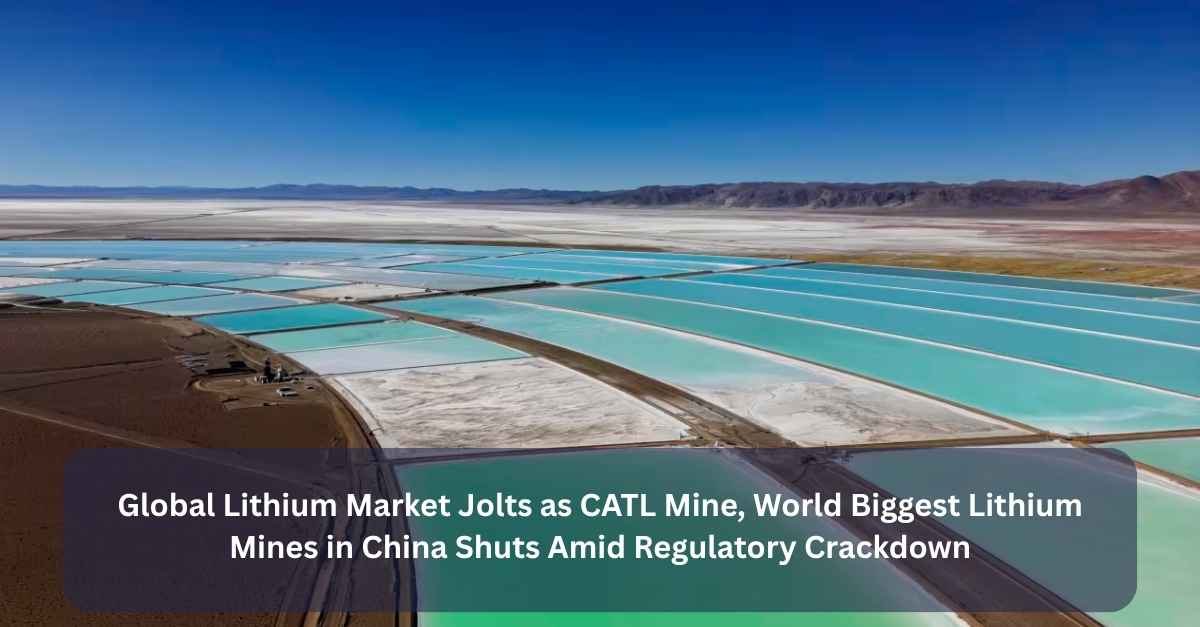The global lithium market was hit hard when one of the top lithium mines in the world, run by China’s Contemporary Amperex Technology Co. Ltd. (CATL) in Yichun, Jiangxi Province of China, stopped working all of a sudden. They had to stop after the mine’s license ran out on August 9, 2025, making the company stop making stuff while they try to get a new license. This has made a big splash in the market, sending lithium carbonate future prices in China up by 8% to their top daily price. This also brought back worries about not having enough supply of a key thing used in new energy tech. The Jianxiawo mine, the main spot of this stop, made almost 3% of the world’s lithium in 2025 enough to change prices and how investor invest across the industry.
Right away, the market reacted a lot. Stocks of big lithium makers across the world went up as people thought there would be less supply and maybe higher prices coming. Chinese makers like Ganfeng Lithium and Tianqi Lithium saw big stock price jumps, and in Australia, places like Liontown Resources, Pilbara Minerals, and Mineral Resources went up as much as 25%. This sharp rise shows not just a quick reaction but more hope that tight supply might make the sector do better after worries of too much supply before.
The suspension shows how big rules are influence the lithium market moves. In the past years, China has really cracked down on having too much and has put in more work rules and regulation to make sure its updated Mineral Resources Law is followed. It looks to push for mining that follows rules better and is more long-lasting. Yichun is often called China’s “lithium capital” and has been a main focus of this tighter control. Stricter scrutiny of licensing and environmental compliance has become the norm adding new layers of operational risk for companies. CATL’s story is a warning to all miners: follow the rules, no matter how big or key you are.
For the EV and clean energy sectors, this stop is both a problem and a chance. Lithium is key for lithium-ion batteries, used in all from electric cars to big batteries that store power. Less supply could make the raw stuff cost more, making it harder for battery makers and car makers to make profit. Since battery costs are a big part of making electric vehicle, even small jumps in lithium prices can change how much cars cost, how many people buy them, and who does better in the market. Some car makers might try harder to lock in supply deals or look at other battery types that don’t need as much lithium, but these changes take time.
In the mining industry, the halt at Jianxiawo could prompt a wave of rationalization. In the mining industry, the halt at Jianxiawo could prompt a wave of rationalization. This shows a big problem for producers when market prices soften, their operations become vulnerable. When the regulatory body in charge step in, it can hasten closures or temporary suspensions, making supply tighter and helping prices in the long run.
The instance also makes room for more players to make lithium around the world. Over the past ten years, China has been the top place for making and, a bit less, mining lithium, putting the world market at risk if something goes wrong there. The current supply shock will likely make other areas market to expand production capacity. Australia, already the top lithium producer in the world, has seen more people want to invest, with new projects getting fund and trust in the market. Also, new emerging producer of lithium in Africa, South America, and even North America are set to do well from such stops, helped even more by government plans and rules that back making key minerals.
This move goes well with bigger plans to make sure we have the important stuff we need. Both the U.S. and the European Union are trying to depend less on China by investing in their own mining projects, making more places that can refine stuff, and working with countries that have lots of resources. The stop at the CATL mine may push these plans even more, as it shows how risky it is to lean too much on one market for things we really need.
Looking ahead, the lithium market will likely stay strong even with ups and downs now and then. The need for lithium is expected to go up a lot in the next ten years, mostly because of electrification of transportation and more clean energy setups. Even as new battery technology comes out, lithium-ion stuff should still lead because it can store a lot of power, works well, and can be made bigger. Supply disruptions like the one at the CATL mine remind us how important it is to plan well, keep the supply chain strong, and put money into new places to make stuff.
In short, CATL’s short break from running one of the biggest lithium mines is more than just a small work stop. It has set off fast price jumps, made investors more hopeful for some makers, and shown how key it is to follow the rules in resource fields. For sectors like making ev cars and storing energy, the break may speed up plans to have different sources and show how we need secure, long-lasting supply chains. For mining places, it’s both a warning and a chance, those that adapt to stricter regulations and rising ESG expectations may not only survive but thrive in the evolving market. While the situation may stabilize once CATL resolves its licensing issues, its broader implications will likely shape industry dynamics for years to come.











